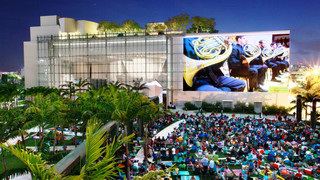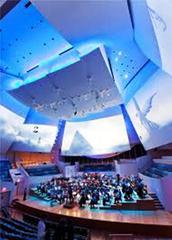|
Back
30 Years of New World Symphony (I)
05/23/2018
This is the first of three articles celebrating the 30th anniversary of the New World Symphony in Miami.

Exterior of New World Symphony at night (© Rui Dios Aidos)
“I look forward to a future where communities and musicians alike work together to carry forward the rich testimony our music represents.”
Michael Tilson Thomas, Co-founder and director of New World Symphony
Several years ago, I asked the directors of the New World Symphony in Miami Beach to describe, in a few words, the actual mission of what they call “America’s Music Academy”. They did a good job in explaining how this was more than a mere “training orchestra” for experienced younger musicians. The New World Symphony, based in a Frank Gehry-designed building, provided space for rehearsals, the 7,000-foot auditorium was an ideal space for public performances. And of course, since the Miami Beach authorities had donated much of the land–an other-worldly donation, since Miami real estate is worth more than gold–the Miami community can enjoy the performances from inside or outside.
At night the windows are dark, but on the east side is a great white wall–370 feet by 360 feet, in a two-acre public park. And on this is a projection of the orchestra, for the hundreds of viewers from all sections of Miami: the tourist area, Little Havana, Little Haiti, and visitors coming from around the globe. They are sitting, standing, drinking (frequently Champagne as well as beer), awaiting something magical.
That, though, was in the antediluvian days when the orchestra was only 25 years old. In the past five years, Michael Tilson Thomas (“MTT” to all who know him) has supervised an enterprise which has exploded like a Charles Ives sonata.
And it’s still difficult to explain what it does. But here goes:
1. Yes, the orchestra. Young musicians from around America (and sometimes from South America) may spend up to six years here, learning, rehearsing, giving concerts.
2. Players as artists. Of course they know their fingerings, their timbres, their vibratos. But through the burgeoning electronic resources here, they can have lessons from First Chair players throughout the world. They can have master classes with MTT himself. They can form consorts and chamber groups which entertain post-concert tourists who frequent South Miami Beach’s night-town.
3. Players as community spirits. Each musicians goes out to the community with personal goals. They might be teachers, they might give concerts–or in one case, a dog-lover rounded up donors of rescue dogs, bringing the animals to the start of a concert. (And no, none of the dogs was named “Johann Sebastian Bark”)
4. The electronic element. This above all has been the major change from my last visit to New World Symphony. Yet, developments even confound Michael Tilson Thomas, each new development animates more constituents.
First, New World Symphony brings in the idea of training for global auditions. By pairing student musicians at international conservatories with some of the world’s foremost orchestral performers, one brings, for the first time, a truly international elements to musical training.
Yet this is not a “uniform” training system. The players come from and learn from institutions like the Shanghai Conservatory, the Cleveland Muisic Institute, the Royal Danish Academy of Music and the Royal College of Music.
Just as all professionals have their individual ways of performing, so they can only coach and suggest. Training younger musicians is not a “McDonald-ization of music”.
Second, New World Symphony has collaborations with cities around America which now have personalized teaching facilities. At a recent visit, two teaching partners from city of Chattanooga, Tennessee, demonstrated how their connections with New World Symphony provided teachers and students with original ways to develop their educational programs.
This is not automatic by any means. Teachers must be taught how to use new “wires”, new methods, new programming techniques.
From a personal viewpoint, I see my own New York sadly lacking. Where we have the most advanced applied computer and technical resources, our teaching in New York schools is dismal. Yes, private schools are advanced in these matters. But elite New Yorkers–those in charge of government educational resources–simply fret and wring their hands and talk about “the crumbling educational system”. They are working with an 18th Century, almost antediluvian attitude, instead of going into the 21st Century and doing something about it.

The Auditorium
Third, on a local level, electronic resources open up performances to innovative design constructs. Those entering the auditorium are greeted by moving decors on each of the screens, modern works are given a visual movement (with the composers’ consent), each work is archived electronically for future study, and each of the approximate pre-programmed up to 700 shots for each work is saved.
4. Giving Back to the World. True, it isn’t easy to change South Miami from a beach resort to a cultural capital. Yet New World Symphony tries. When the Orchestra gives a concert, the outdoor and indoor spaces are packed with people, many of whom hadn’t previously heard the names Dvorák or Tchaikovsky.
I was seated next to a Jamaican lady who went to every concert, who considered it a privilege. She asked me if I knew “information” about the Dvorák Eighth Symphony to be performed. And I attempted an explanation of what to hear, of the last-movement variations, of the Czech dances. When Maestro Thomas came to the stage, giving a short talk introducing the players and the music, she was fascinated. And at the end of the Symphony, she turned to me with a beatific smile.
“That is why I love this place,” she said. “My world opens each time I hear it.”
Secondly the New World Symphony enjoys the “Side-by-Side” concerts. These give an opportunity for young instrumentalists, grades 7-12, to perform along their more experienced “fellows”. They share the stage, they rehearse, they are coached by Micheal Tilson Thomas, and learned to play music of the highest caliber. These 47 musicians are selected through electronic auditions around the world.
5. A Building For A Future. Amidst Miami’s restored Art Deco art and grandiose hotels, it would be easy to overlook the building which houses their artists, each of whom serves up to six years with New World Symphony. The architect Frank Gehry has created many a flamboyant erection in his time. But this building looks, from the outside, at the least, prosaic, far different from his usual audacious structures.
Though the six stories look like an office building during the day, the endless windows show off every rehearsal room, conference and meeting room. Inside, Gehry’s well-known bends and folds are only hinted at from the park outside.
The details of the design differ much from Frank Gehry’s usual audacious structures. The building is simply rectangular, six stories high, apparently made for offices. But the Gehry inspiration comes in two ways.
First from those countless windows which show off every single rehearsal, conference and meeting room for every passerby. In terms of design the building’s exterior portrays a quiet, almost tamed Frank Gehry. The rectangle-shaped white building expresses Gehry’s well known bends and folds within its interior – glimpses of which are visible through the main entrance east facade 80 foot high glass curtain wall. You can’t simply look up or down, since rooms are jutting out from the walls, the staircases, the inner folds.
The floors can be utilized for meetings, seminars, yes, 24 sound-proofed rehearsal rooms. But these days virtually all of it has been electrically, computer-ishly configured to broadcast interviews, or master classes from and to around the world.
The center is the auditorium–or rather several auditoriums. The 7,000-square-foot room has tiers of seats which can rise in several configurations. Nearly 800 listeners can enter from the two narrow corridors which wind up from the lobby.
But those listeners enjoy a surprise each time they enter. While trapezoidal in form, the stage, the seating, the wings can make at least 14 different incarnations. Depending on how the wings go, how the tiers can be raised or put flat on the floor, and even the use of four satellite platforms, the stage can be utilized for everything from opera to chamber music to last month’s gorgeous concert of Dvořák, Tchaikovsky and Ginastera.
While the hall is not geared to change the sounds through computers (as do many of today’s new listening halls), MTT wouldn’t find that necessary. This still is one of the most innovative concert halls in America.
Added to this, the nightly concerts in the balmy Miami air, where one can see even more of the Gargantuan stage with these screens. All of this is a basis to make the , makes the New World concept, both innovative and exciting.
(Tomorrow: Michael Tilson Thomas and the advancement of New World Symphony)
Harry Rolnick
|